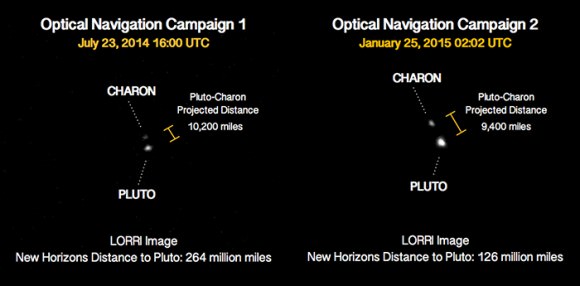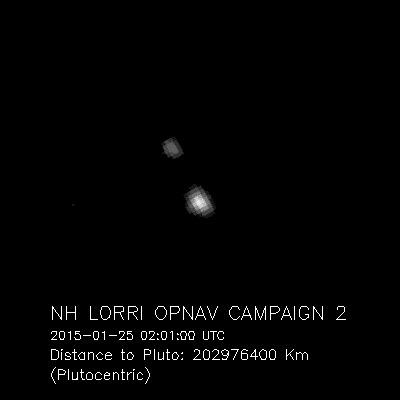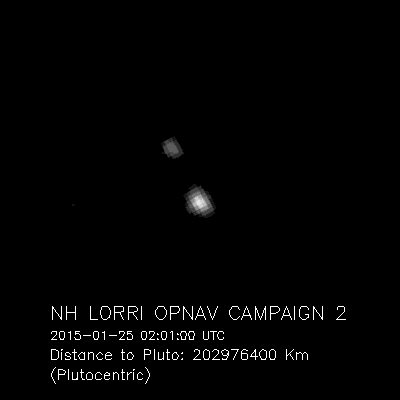Here we go! New Horizons is now on approach and today – on the anniversary of Pluto discoverer Clyde Tombaugh’s birth – the spacecraft has sent back its first new images of the Pluto system. The images aren’t Earth-shattering (Pluto-shattering?) but they do represent the mission is closing in on its target, and will allow the New Horizons engineers to precisely aim the spacecraft as it continues its approach.
The photos were taken with the telescopic Long-Range Reconnaissance Imager (LORRI) on January 25 and 27, 2015.
“Pluto is finally becoming more than just a pinpoint of light,” said Hal Weaver, New Horizons project scientist. “LORRI has now resolved Pluto, and the dwarf planet will continue to grow larger and larger in the images as New Horizons spacecraft hurtles toward its targets. The new LORRI images also demonstrate that the camera’s performance is unchanged since it was launched more than nine years ago.”

New Horizons was about 203 million kilometers (126 million miles) away from Pluto when it began taking images. Pluto appears as a pixelated smudge, and New Horizons is only close enough so that just Pluto and its largest moon, Charon are visible. In this current view from LORRI, Pluto is about 2 pixels and Charon is 1, compared to 1 pixel and 0.5 pixels last July. The images were magnified four times to make Pluto and Charon more visible.
NASA says that over the next few months, LORRI will take hundreds of pictures of Pluto, against a starry backdrop, to refine the team’s estimates of New Horizons’ distance to Pluto. As in these first images, the Pluto system will resemble little more than bright dots in the camera’s view until late spring. However, mission navigators can still use such images to design course-correcting engine maneuvers to direct the spacecraft for a more precise approach. The first such maneuver based on these optical navigation images, or OpNavs, is scheduled for March 10.

Image Credit:
NASA/JHU APL/SwRI
Closest approach for the spacecraft will be on July 14.
These first images represent a milestone.
“These images of Pluto, clearly brighter and closer than those New Horizons took last July from twice as far away, represent our first steps at turning the pinpoint of light Clyde saw in the telescopes at Lowell Observatory 85 years ago, into a planet before the eyes of the world this summer,” said Alan Stern, New Horizons principal investigator. “This is our birthday tribute to Professor Tombaugh and the Tombaugh family, in honor of his discovery and life achievements — which truly became a harbinger of 21st century planetary astronomy.”
During its flyby, New Horizons will be characterizing the global geology and topography of Pluto and Charon, mapping their surface compositions and temperatures, examining Pluto’s atmospheric composition and structure, studying Pluto’s smaller moons, and searching for new moons and rings.


Does it look to anyone else like we’re approaching the Pluto system from the side looking at a quarter phase?
Pluto is tilted 120 degrees, to be compared with Earth’s 23 degrees. Its moons go more up and down than sideways. The two images here show about one quarter of a revolution of Charon. The next two images with the same interval would show Charon above and to the right of Pluto, describing an ellipse. (Or else I’ll eat another hat)
the orientation of pluto doesn’t govern the shape of its illuminated side but I do take your point that the orbit of the moon is highly inclinded relative to the ecliptic.
For your hat’s shiny purpose on your head, do leave it there.
http://phys.org/news/2015-02-full-day-pluto-charon.html
But I’d like to see a real discussion of the orientation of New Horizon’s approach vector to Pluto…
This seems to imply we’re headed “straight out” so to speak. Which leaves this gibeous Pluto image confusing to me.
http://i.space.com/images/i/000/008/716/original/20110318_lg.jpg?1300482230
Confirmed with a more recent url http://pluto.jhuapl.edu/whereisnh/overview/nhov20150201_0308.jpg
So… odd.
Another question is what is the orientation of the Pluto system? I mean ok 120* but for example this graphic – http://spaceplace.nasa.gov/review/ice-dwarf/SolarSystem_side.en.gif
shows it 120° in some direction – but I have little idea what that is. And then there’s the orientation as we come towards it.
This one might be approximately what NH is coming up towards…. http://spaceplace.nasa.gov/review/ice-dwarf/pluto_orbit.en.gif
Can we make inferences about phase from an object that subtends two pixels? I thought a bit about what the phase should be. New Horizons is approaching from inside Pluto’s orbit, so the phase would have to be at least half.
Is the New Horizons nav team going to attempt to pass Pluto as closely as possible, or are they, for some reason, planning the flyby for some specific distance from the Pluto system?
iirc, the team is – at the moment – shooting for one of the orbital gaps between Pluto and its outer moons, as well as roughly on the opposite side from where Charon will be at closest approach. This path allows the craft to get as close as possible to the central system while minimizing the chance of running into any other orbital bodies (dust, moonlets, etc.) they haven’t yet been able to detect.
According to JPL’s website, they still have several TCM opportunities left, so they can still make minor adjustments to that path as observations, needs, &/or wants dictate.
Smoky, Thanks much for that quick and informative reply!
As far as I remember, NH will cross the system plane near Charon’s orbit, which is expected to have been cleared of debris by Charon.
More here:
http://www.planetary.org/blogs/emily-lakdawalla/2014/12031700-the-new-horizons-science.html
“The moment of the flyby was chosen carefully to allow solar and Earth occultations by both Pluto and Charon, which will allow New Horizons to probe their atmospheres. Fortuitously, this moment was also the best for surface studies, with good views of Pluto’s bright terrain, dark terrain, bright/dark transition, and carbon monoxide-rich longitudes. It was near optimal for viewing Nix and Hydra, and had Pluto/Charon separations that needed little slewing time to move between them.”
I found this ancient graphic https://web.archive.org/web/20060929075918/http://pluto.jhuapl.edu/mission/images/pluto_encounter3.jpg
Apparently a lot of geometry is going into aligning NH so it gets in the shadow from earth for both Pluto and Charon and the angle is coming up from “beneath”
“My God! It’s full of moons!”